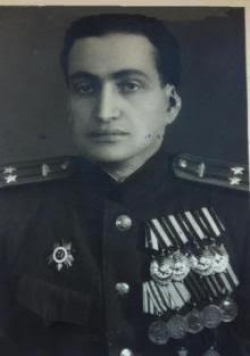Semion Fishelson was born in 1921 in the town of Velizh (now in Smolensk Region; Russia). After finishing a seven-year school in 1935, Semion moved to Smolensk, where he first worked as an assistant machinist at a factory, and then as a lathe-operator and repairman.
In 1939, Fishelson was drafted into the Red Army, taking part in the Soviet-Finnish Winter War of 1939-40.
Following the German invasion of the Soviet Union in late June 1941, Semion Fishelson was immediately sent to the Riga Infantry School, which was relocated to the Soviet rear (the town of Sterlitamak in Bashkiria) for the duration of the war. In April 1942, having completed his course (which, given the circumstances, was taught in record time), he was sent to the front. In the course of the war, Fishelson was, at various times, deputy commander of a motorized rifle battalion, commander of a motorcycle battalion, commander of a tank regiment, commander of a heavy self-propelled artillery regiment, and assistant commander of a tank brigade. He took an active part in the fighting for Stalingrad, and fought in the Zaporozhie area. There, in the fall of 1943, thanks to a tank assault in which Fishelson took part, the Soviet troops managed to force their way across the Dnieper River. Fishelson also participated in the liberation of the city of Mogilev (Belorussia) and in many other battles. He was wounded several times, once seriously. Toward the end of the war, in March 1945, the tank in which he was riding went up in flames in a battle near Gdynia (Poland). Fortunately, Fishelson was rescued from the burning vehicle by his assistant, Nikolai Rodionov. Covered with burns of various degrees of severity, Semion was taken to a hospital, where he remained until the end of June 1945.
Lieutenant Colonel Fishelson was nominated for the title of Hero of the Soviet Union on three occasions. The first time, in November 1941, he was recommended for his participation in an operation in the area of Pułtusk-Różan, northeast of Warsaw. The second nomination (in April 1945) cited his actions in the city of Gdynia; although his candidacy was supported by Marshal of the Soviet Union Konstantin Rokossovskii, the higher authorities disagreed, and Semion did not receive the gold star that symbolized this highest of honors. The third time that this Jew was nominated for the coveted title was in June 1945. On each occasion, he would be given a lesser award. Thus, over the course of the war Fishelson was granted four Orders of the Red Banner, one Order of the Patriotic War, 1st Class, and a number of medals.
After the war, Semion continued his military career, serving at different times as commander of a tank regiment, assistant commander of a guards motorcycle regiment, etc. His last post, before he was retired to the reserves, was senior officer of the Iaroslavl Region military commissariat.
In 1954, after the death of Stalin, Fishelson asked the newspaper Pravda to reexamine his nomination for the title of Hero of the Soviet Union and explain why he had been denied it. The newspaper forwarded his appeal to the Ministry of Defense, which gave the following reply: "You were, in fact, recommended to receive the title of 'Hero of the Soviet Union' twice [the third instance is not even referred to]. After reviewing the materials, the High Command did not find it possible to award you the title of Hero, but instead ruled in favor of awarding some [lesser] decoration. In both cases, you were awarded Orders of the Red Banner, which were presented to you. Since, with regard to granting you the title of "Hero of the Soviet Union", a decision was already made by the Command at the time, there are no grounds for overturning that decision at present." (October 12, 1954).
Semion Fishelson died in 2008 in Vilnius (Lithuania), and was buried at the Jewish cemetery there.







